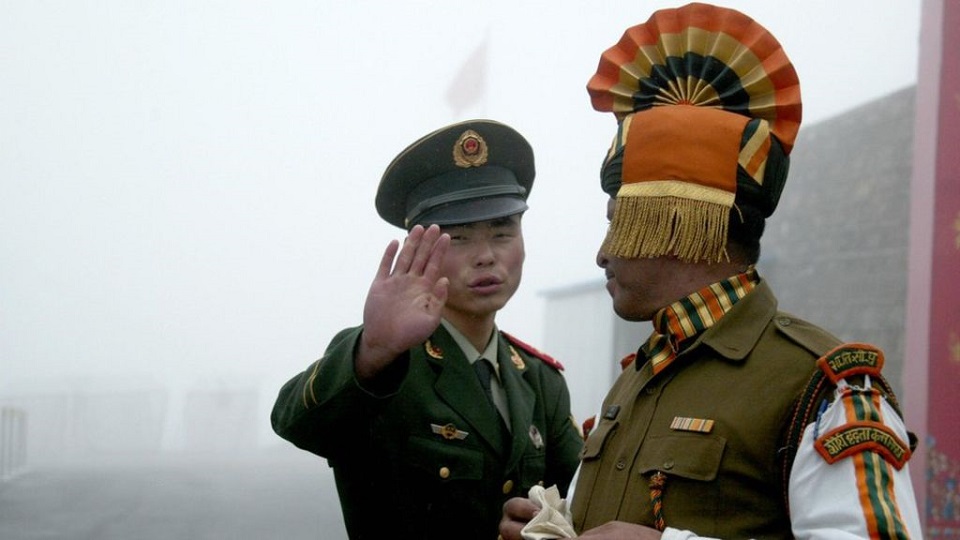- By: Suresh Sharma

As India and China are accusing each other of crossing the LAC, it could trigger a potential spark for a limited war.
The memories of fierce clash between Chinese PLA and Indian militaries in Galwan of June remain. And yet fresh tension has emerged at Line of Actual Control (LAC). The Indian military is now caught in an uncertainty as to where the agreement of status quo
with Chinese forces will end. The chase for holding tactical north as well as south bank of Pangong Tso Lake where the LAC passes has raised many questions. Indians think the tactically important high grounds such as Black Top, Helmet, Gurung Hill, Maggar Hill, Spanggur gap along with some other on the south bank of Pangong Tso, ground between Rechin La-Rezangla-Mukhpari and Magar Hill, if held and sustained, would provide them advantage to dominate PLA’s position and prevent surprise incursion from them.While many of the Indian media glorified this hold by preempting PLA’s move, the Chinese Embassy in Delhi blamed India for violating the consensus and crossing the LAC. On September 8, warning shots were fired on LAC from both sides, and tensions rose. Statement of China’s western theatre command (WAC) said border troops of the PLA were “forced to take countermeasures” after Indian army soldiers fired at them near the Shenpao mountain region near the south bank of Pangong Tso. The new situation along LAC has become a worry for the troops holding grounds on both sides in approaching icy winter.
Talks are failing
The talks between India and China for the last three months have not made headway because both have put claim on these important heights and feel threatened if they are occupied by the other party. China does not seem to agree to India’s demands to return to pre-May status. It could be one of the reasons, India’s Chief of Defense said, “defense services always remain prepared for military actions should all efforts to restore status quo along the LAC do not succeed.” Some Indian security experts have accused China of trying to create a new status quo by not agreeing to India’s terms. To add fuel to the fire, some retired Generals are even advocating for military actions against the “salami slicing tactics” (their terminology for PLA inching forward in LAC).
South block, it seems, is less likely to take notice of this until Indian forces will be physically threatened by PLA, and the protection of Chusul bowl, Daulat Beg Oldie (DBO) and other rear areas becomes inevitable. But, with any sudden rupture in confidence building measure (CBM), neither India’s military would merit an advantage at the LAC, nor achieve their perceived status quo. Due to new impasse, each disputed piece of ground will remain in quandary for long.
Getting worse
If we recall the history of November 1962, Indian troops had claimed that they thwarted incursion attempts of the PLA and thereafter got hold of mountain tops (same as above )—which were of advantageous positions—so that PLA could not come further inside Indian territory. Once the PLA attack became intense with artillery and mortar fire mixed with infantry on Indian posts at Rezang La, Maggar Hill, Gurung Hill and Spanggur gap those positions had to fall in the face of their overwhelming superiority.
Thus security experts’ view that possessing some other heights along LAC subsequently would give advantage in the negotiating table does not hold water. If that is the design of Indian military then PLA’s move will create catastrophe. The race in capturing, holding, and then dominating the important heights in the LAC (disputed area of ground) to one’s advantage could prove to be potential flash points.
In an interactive session at the US-India Strategic Partnership Forum, few days ago, India’s Chief of Defense Staff (CDS) General Bipin Rawat said India's policy of engagement, if not backed by credible military power and regional influence, would imply acknowledging China's pre-eminence in the region. Essentially, the warmongering and provocation adds fuel to misunderstanding and the soldiers will further bleed in the most inhospitable high altitude terrain for nothing. The aspiration of India-US rock-hard strategic underpinning of an offensive theater in the region for all intents and purposes would become counterproductive.
Point to ponder
As India and China are accusing each other of crossing the LAC, it could trigger a potential spark for a limited war, like that of 1962, but with a different magnitude. Inviting the military confrontation, as advocated by Indian CDS and provocation will result in mere loss of blood. Political warmongering as not to “cede an inch of land” to protect the integrity and sovereignty of the country at all cost consolidates the current status.
Each side has issued statements over LAC in recent days. The countries in the region have drawn attention for restraint. The top level security mechanisms of both countries need to realize that transgressions along the LAC occur due to differing perceptions about its alignment. Their perceptions can only converge if a new idea of peaceful solution is sought from both sides.
GO TO HOME PAGE
Now more than ever, support the IT sector
Still, the government is yet to expand innovations in the IT sector to practically relieve people from hurdles caused by work procedures in various government offices. Without electronic operation facilities, a person seeking service either has to stand in a long queue and linger for several consecutive days at government offices, or look for a third person’s assistance to get a simple work done at any given time. The impending goal of making digital Nepal will not become possible unless responsible officials devise a system that electronically manages application submissions. If the government does not make these services digital with IT applications, issues like corruption and bribery may stick around for even longer.
At a time when the government is struggling hard to achieve its revenue collection goal, already running negative in the second quarter of the current fiscal year due to the pandemic, policy makers should look towards innovation of new procedures in e-commerce. Through IT, the government can launch simpler and improved procedural systems for e-commerce to ensure that required services are made available to citizens through online infrastructures and softwares. With this, the government can bring convenience to people’s lives, especially during these times of uncertainty. Such an example could be being able to file taxes online using a Finance Identification Number (FIN) or Permanent Account Number (PAN) through a bank account, or pay recurrent tax electronically to the local ward office, or register through e-pay and later collect or print the receipt, or begin e-heath and expedite e-education with new methodologies.
In 2018, the government made news headlines for handing out laptops to Ministers at the beginning of a digital meeting. After seeing that, citizens hoped for ease with their work at various offices like district courts, municipalities, wards, company registrar, tax and land revenue among others. In these offices, the middleman facilitated work. Although this person could, to some extent, eases the work as mostly seen in land and property transfer services (in Malpot offices), department of industry and commerce, offices like district courts, transport management, company registrar, labor, passport and several others required agents’ assistance as the public had no access to a desk officer, nor to an electronic correspondence.
Ironically, the insertion of middlemen increased costs of commission at both ends, and created an atmosphere for corruption and bribes. Speaking to a relative who lives in the States a few days ago, I questioned if such practice existed there to grant permission to start up a new business, or for the processing and renewal of existing business. He negated that all they need there is to handle required documents electronically and the customer would be timely serviced to their full satisfaction without any hassles. However in Nepal, there are numerous instances where officials ask for commission or bribes for getting simple tasks and service done.
In Nepal, social media platforms are becoming widely used for socialization and are becoming popular day by day. It has become easier to create a bank account or transfer funds, validate a share transaction or pay any bills with the digital service through social media apps. Many ministries and departments including offices like transport management, company registrar, land and survey, courts, Inland revenue where the public face hassles in procedures invite middlemen to establish a link between them. In a changed context, where the public is already familiarized with systems of electronic payment services such as eSewa, IMEpay, and Khalti, as well as with various online shopping apps and websites, why can’t the government also make their desk offices electronically accessible to the public? An emphasis should be made in urban areas for the use of electronic correspondence to deliver services that do not require middlemen. In regard to rural areas where IT knowledge is not as prevalent, some other appropriate procedures can be adopted.
With the introduction of the electronic submission system, commonly provided public services like issuing caste, birth, marriage, death and relationship certificates, copies of land records, values, passports, approvals of start-up, license renewals, citizenship certificates, various tax submissions and several others would become easy especially in terms of efficiency. Otherwise, these processes can be time consuming and frustrating, not to mention the possibility of corruption occurrences. A dishonest bureaucracy can be discouraging to citizens, as it unnecessarily delays and complicates matters and encourages misappropriations.
The government should realize that IT can be extremely valuable during these times when the entire world is dealing with a pandemic. It should thus begin electronic correspondence efforts to simplify work in service sectors such as e-commerce, health and education with efficient IT applications. The concerned ministries should soon begin to think of ways to innovate and digitalize public services, and they should put these on their priorities, with an aim to make the services convenient, efficient, bribe-free and cost effective to the public .





No comments:
Post a Comment
बेनाममा अरुलाई गाली गलौज गर्दै जथाभाबी कमेन्ट लेख्नेहरु लाई यो साईटमा स्थान छैन तर सभ्य भाषाका रचनात्मक कमेन्ट सुझाब सल्लाह लाई भने हार्दिक स्वागत छ । तल Anonymous मा क्लिक गर्नुश अनी आफ्नो सहि नाम र सहि ईमेल सहित ईंग्लिश वा नेपाली मा कमेन्ट लेखी पठाउनुश, अरु वेबसाईट र यस् मा फरक छ बुझी दिनुहोला धन्यवाद । address for send news/views/Article/comments : Email - info@nepalmother.com - सम्पादक